
Carnivorous Plant Soil Mixes



Soil Mixes for Carnivorous Plants, Bog Orchids and Bog Plants
Carnivorous Plants worldwide grow in similar conditions: sunny, moist, peaty soils. Like any other generalization, there are exceptions and variations to this. Sarracenia purpurea, the Purple Pitcher Plant, typically grows in bogs with peaty, acidic soils, but there are localities in marls where it grows in sandy alkaline conditions. Drosera rotundifolia, Round-leaved Sundew, prefers live sphagnum, where as Mexican Butterworts, Pinguicula spp., are often found growing in cliffs and crevises of limestone. The point being, that generalizing and saying that carnivorous plants grow best in a peat: sand potting soil mix, does not account for the soil diversity of their habitats or variation of composition within a single location. Consider the fact that the soil profile of a woodland bog would reveal a continuum of composition from soggy peat in the center, to moist peaty sand in mid bog, and humusy, sandy, peat along the woodland margins. Different Carnivorous Plants could be found in these different soil zones, and some Carnivorous Plants would be spread throughout all of them. This is because there is a continuum of tolerance for soil variation among Carnivorous Plants. For some, the tolerance range is quite narrow, for others it is extremely broad.
That being said, if you want to make your own DIY carnivorous plant soil, there are two basic ingredients: peat moss and sand. Not just any peat or sand, but sphagnum peat moss and washed "river sand." Sphagnum moss grows in nearly all carnivorous plant habitats. As it dies and decays it turns into sphagnum peat moss. This is common in the eastern United States and not to be confused with sedge peat which can be found in the western US. The sand is typically of quartz origin and free of minerals from constant washing and inundation of flowing water. This "river sand" is sometimes called "horticultural sand." It should not be confused with "contractor's sand", which contains clays and fine particulate dust loaded with minerals. Remember minerals burn Carnivorous Plant roots and are to be avoided in any Carnivorous Plant soil mix. Most carnivorous plant growers use a general mix of peat:sand at 50:50. The ratio is not critical for carnivorous plants with a wide range of tolerance for soil conditions. For others the ratio and supplemental components can make a difference in whether or not the carnivorous plants grow, "hang in there," or thrive. This is why Carnivorous Plant Nursery provides a variety of carnivorous plant soil mixes for potting. Each is custom mixed for the particular requirements of the carnivorous plants it is designed for. This has been developed through years of growing experience, including success and failure, as well as field study of many different carnivorous plant habitats worldwide.
These concepts hold true for other bog plants including the bog orchids.
Carnivorous Plant Soil Mixes:
All Purpose Mix: For General Growing of Carnivorous Plants
Upper Bog Mix: For Venus Flytraps
Lower Bog Mix: For Sarracenia, Sundews, Terrestrial Bladderworts, Genlisea, Bylbis
Tropical Butterwort Mix: For Tropical Butterworts
Nepenthes Mix: For Nepenthes, Heliamphora, Ephytic Bladderworts, Bromeliads, Darlingtonia
Cephalotus Mix: For Cephalotus follicularis
Bog Orchid Mixes:
Bog Orchid Mix: For Calopogon, Spiranthes, Platanthera, Bletilla, Tipularia, Pleione
Lady's Slipper Mix: For Cypridium acaule, Disa, Australian spp.
Lady Slipper Mix with Lime: For C. praviflorum, C. pubescens, C. reginae, Galearis
Our Soil Ingredients:
Long Fiber Sphagnum Peat Moss: Dried, natural Canadian Sphagnum Moss
Milled Sphagnum Peat Moss: Canadian Sphagnum Peat Moss screened 1/4"
Horticultural Sand: Washed, sterilized, <1/8"
CaCO3 Sand: Calcium Carbonate sand and/or aragonite, washed, sterilized, <1/8"
Perlite: Horticultural Grade, screened, fine (≤ 1/4" ±)
Fir Bark: Finely chopped Douglas Fir bark, (≤ 3/8" ±), partially decomposed
Chopped Sphagnum: Long fiber, Grade AAA, unmilled or cut to 1-2+"
Pine Bark Fines: Finely chopped (≤ 3/8" ±) Loblolly Pine bark, partially decomposed
Leaf Mould: Finely chopped (≤ 3/8" ±) Oak and/or Beech leaves, partially decomposed
Pellet Lime: Horticultural Grade, fine (≤ 1/4" ±)
Our Recipes:
| Mix Name | Plants | Milled Peat | Hort. Sand | CaCO3 Sand | Perlite | Chopped Sphag. | Pine Park Fines | Leaf Mould |
|---|---|---|---|---|---|---|---|---|
| All-Purpose | General | 3 | 1 | 1/2 | ||||
| Upper Bog | VFT | 5 | 3 | 2 | ||||
| Lower Bog |
Sarracenia Sundew Terrestrial Bladderwort Genlisea Bylbis |
5 | 1 | |||||
| Tropical Butterwort | Butterwort | 1 | 1 | 1 | 1 | |||
| Nepenthes |
Nepenthes Heliamphora Ephytic Bladderwort Bromeliads |
1 | 3 | |||||
| Cephalotus | Cephalotus | 2 | 1 | 1 | ||||
| Cobra Lily | Darlingtonia | 5 | 3 | 2 | ||||
| Bog Orchid |
Calopogon Spiranthes Platanthera Bletilla Tipularia Pleione |
3 | 1 | 1 | ||||
| Lady's Slipper |
C. acule Disa Australian spp. |
1 | 1 | 1 | 1 |
